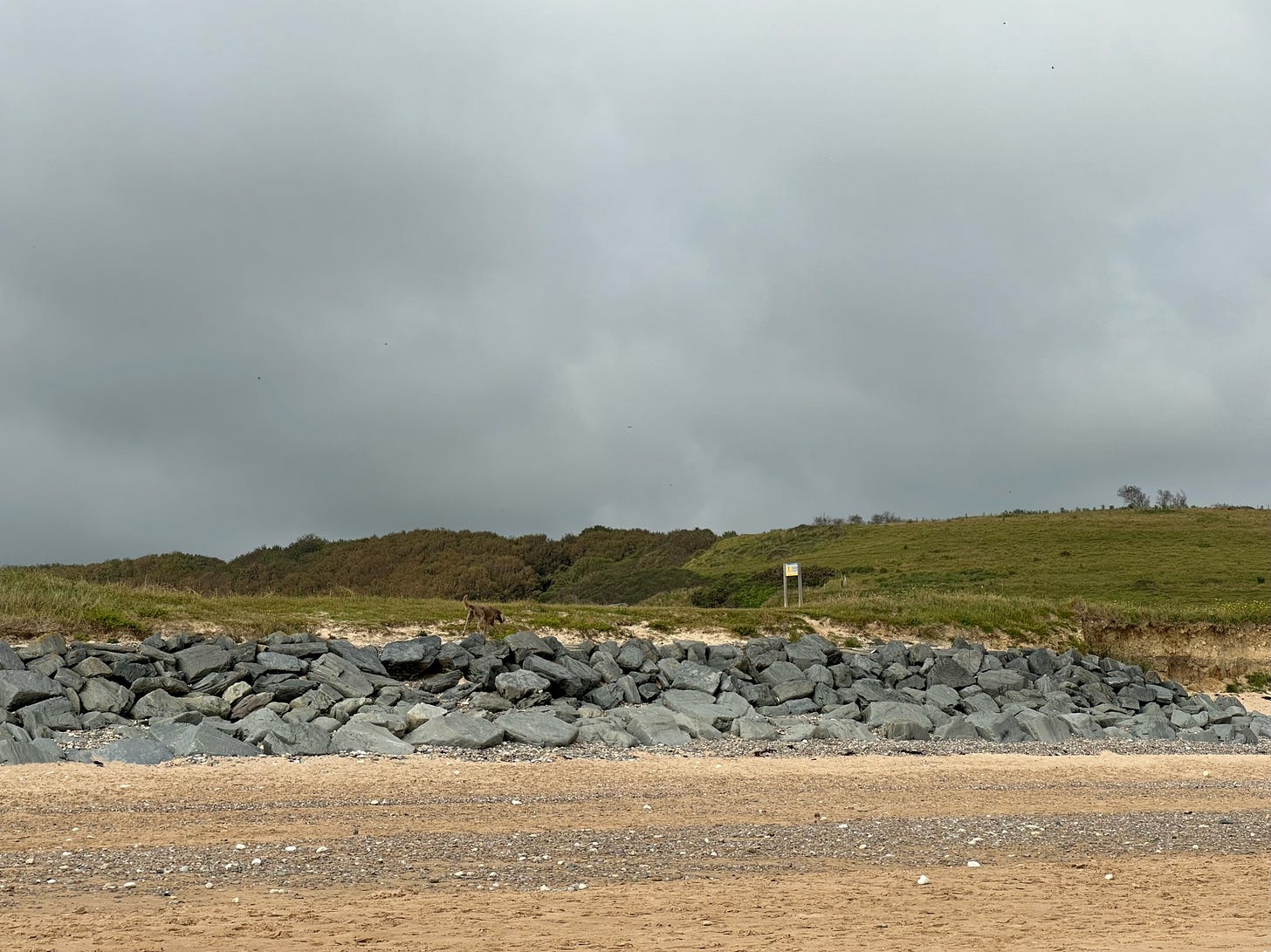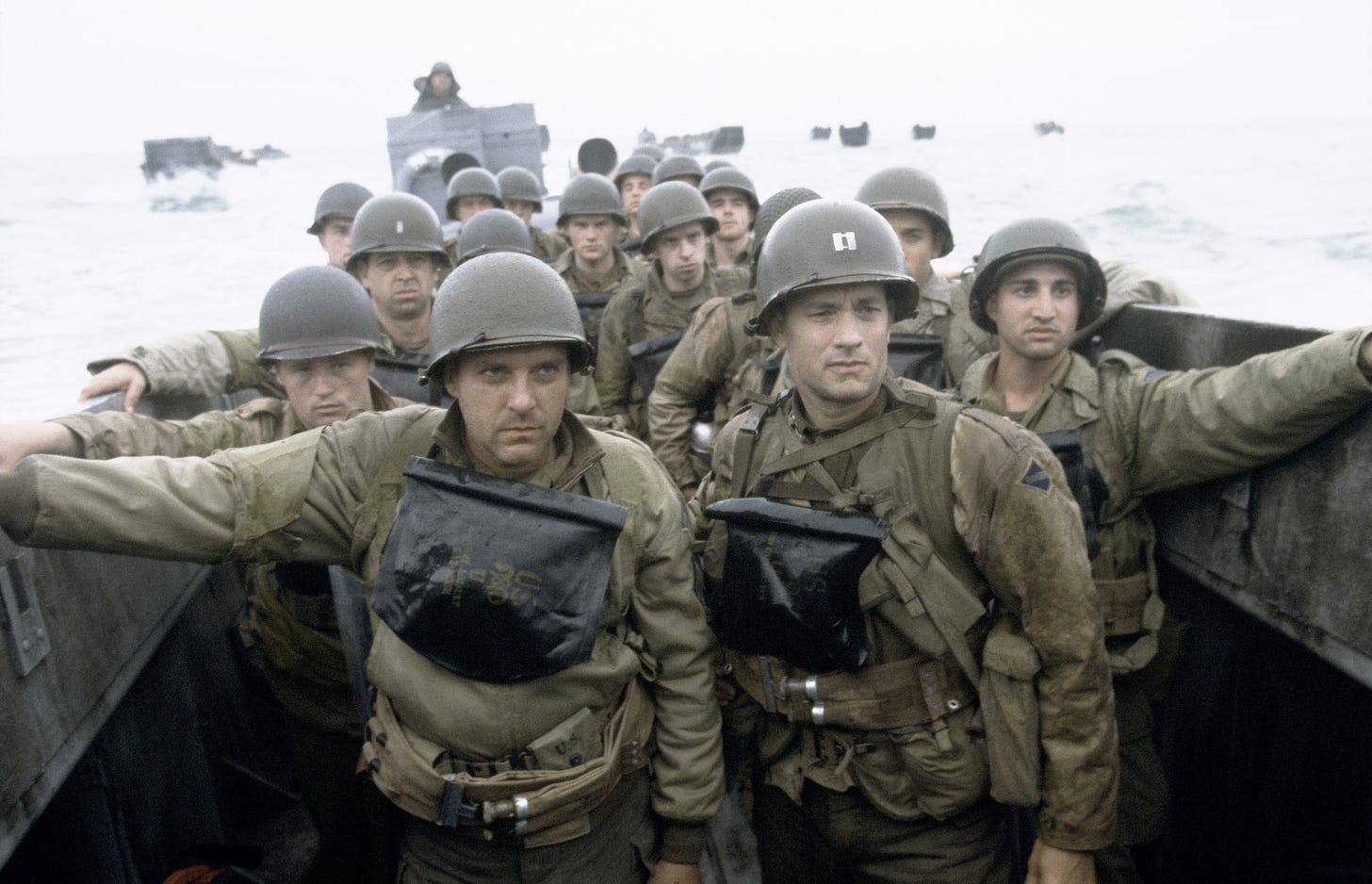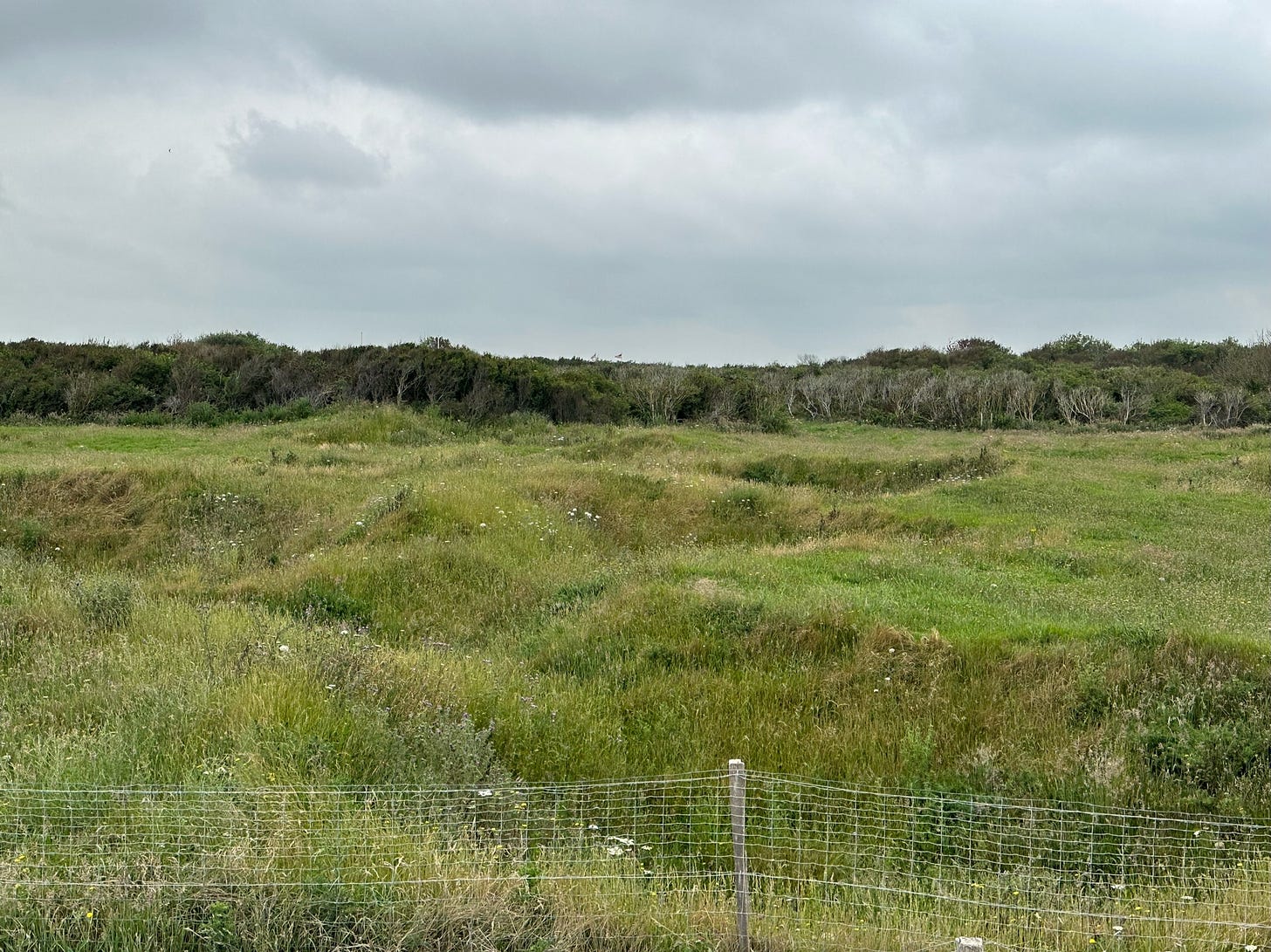The Spirits of Normandy
A recent tour of D-Day sites and a second viewing of 'Saving Private Ryan' offered a lesson on how we remember.
During the Nazi occupation of France in World War II, Pointe du Hoc in Normandy was understood by both sides as an important strategic post for the Germans in thwarting an Allied attack. Located a few miles to the west of Omaha Beach, Pointe du Hoc was a natural high point in Hitler’s “Atlantic Wall,” perched atop a 35-meter cliff overlooking the English Channel and (potentially) fortified by massive 155mm GPF guns that could take aim at the beaches below. (It’s a grim irony that these guns, designed by the French during World War I, were being used against them.) As part of the D-Day operation on June 6, 1944, three companies of elite U.S. Rangers were to use ropes and ladder to scale the cliffs and take out the guns—a misadventure that would eventually lead to triumph—but first, the German resistance was to be softened by aerial support from above.
I visited Pointe du Hoc last week as part of a tour of D-Day sites that included Omaha Beach and the American Cemetery, and many of the physical remnants remain intact, like an observation bunker and the circular gun pits meant to house the 155mm guns. But most striking to me were the craters from the aerial strikes that still pockmark the area around Pointe du Hoc, which are now covered in grass, reclaimed by the wild verdancy of the Normandy countryside. The Nazis torched much of the landscape close to the beaches, and the rest of it was ravaged beyond recognition by the men and machines of war. Yet Mother Nature is a patient and inevitable force: The craters are now merely scars and the vegetation and overgrowth that had defined the area, snaring the lumbering tanks and slowing military operations, has had the last word.
Omaha Beach has no such evidence of conflict, because the Allied bombs intended to wipe out the machine gun nests along the ridge on the morning of June 6th had completely missed their target. The rough seas that had claimed 27 of the 29 tanks that were to land alongside the first wave of American infantry soldiers, who had to face a fully intact German defense without this artillery for cover or support, leading to a nightmarish three hours where they were trapped in a killing zone of mines and gunfire. Visiting Omaha Beach today, there’s even less evidence of the gruesome battle that has occurred 79 years ago, as the tides made quick work of sand and the once eight-foot ridge-line that gave the Germans a huge positional advantage over the Americans has been whittled down to a few feet of rocks. What stood out for me, in walking around the beach during low tide with my family, is how close the ridge is to the waterline. It would not have taken great marksmanship to wipe out the men trudging forward through the waves and sand.

Standing on Omaha Beach is an emotional experience, made more vivid by our guide’s sober description of what happened on June 6th, but if it weren’t for the signpost marking the spot, it wouldn’t be an obvious historical site like Pointe du Hoc. It takes some imagination to bring it to life. More specifically, it takes Steven Spielberg’s imagination to bring it to life. I waited until after our France excursion to revisit Spielberg’s Saving Private Ryan for the first time since its release in 1998, but certain shots from the famed D-Day sequence toward the beginning of the film stayed with me: The tremors of Capt. John H. Miller’s (Tom Hanks) hand as he tries to cap his canteen before the landing craft reaches shore; other men vomiting from a combination of seasickness and nerves; the scores cut down the moment the craft’s gate is lowered; and the surreal moment when a wounded soldier picks up his own severed arm and continues a lonely, doomed assault on the beach.
Yet there’s one image that stands above all others: The blood-streaked waves lapping gently to shore hours later, carrying the prone bodies of dead Americans, along with their equipment and the odd fish that turned into collateral damage. Spielberg had turned to such imagery before in Jaws, when he used the reddened water as a suggestive reference to the savagery of a Great White shark off the coast of Amity Island. But in Saving Private Ryan, it serves a purpose similar to the theme of Terrence Malick’s ensemble war movie The Thin Red Line, which had been released the same year: War is a violation of nature, and the only long-term assurance is that nature is more persistent. The blood and bodies will lap away eventually and only their spirits remain.
The Normandy invasion sequence remains the most gripping stretch of Saving Private Ryan, though any mortal filmmaker would also envy Spielberg’s work on a battle over an important bridge in the fictional inland village of Ramelle. The rest of the film has the shape of a more conventional war picture, with plenty of downtime spent sketching the relationships between Miller and the men under his command. Miller’s unit has been tasked with the special mission to track down James Francis Ryan (Matt Damon), one of four sons an Iowa family has sent to war and now the only survivor, missing in action after an errant drop scattered his airborne unit around Normandy. High up the military food chain, it’s been decided that the Ryans have sacrificed too deeply to get a fourth “we regret to inform you” telegram, so Miller has to find this needle in a haystack while beating back intense German resistance. That’s a lot to ask of a unit that just survived Omaha Beach semi-intact.
Though Miller is inclined to follow the chain of command dutifully, he wonders why the lives of his men are put at such grave risk to save only one, and his subordinates are even less subtle about it. They have a bone-deep understanding that they’re all brothers, on equal footing, and no single life is more important than another. So what makes James Francis Ryan any different? (The American Cemetery at Normandy was organized around the same concept. The headstones are completely randomized, without respect for rank or religious affiliation or even the alphabet.) When they finally do luck out and find Ryan, he not only has the same question, but is so incredulous about leaving his comrades that he barely registers the loss of his three siblings.
The soldiers under Miller’s watch are stock war-movie types, though each have their standout moments. There’s Ed Burns as the most openly opinionated of the lot; Barry Pepper as a religious sniper who prays before kills; Tom Sizemore as Miller’s brash second-in-command; Vin Diesel as the toughest of tough guys; Adam Goldberg as a Jewish wisecracker who lives to taunt his Nazi captives; and Giovanni Ribisi as the combat medic. The odd man out—and by far the film’s most controversial figure—is Jeremy Davies as Timothy Upham, a woefully inexperienced staff assistant brought onto the team for his ability to serve as a French and German interpreter. When he has the opportunity to save one of his comrades during a man-to-man fight in a hollowed-out church tower, Upham freezes in terror and his cowardice exacts a heavy cost.
In the broadest strokes, Saving Private Ryan has a war-movie traditionalism that seems to connect to Spielberg’s childhood—at least the one depicted in The Fabelmans, when the prodigious teenager would stage his own version of a matinee shoot-‘em-ups. The Upham character, though, is a startling affront to conventionality, because we’ve been trained as an audience to assume that this slight man, who warns Miller that he hasn’t picked up a weapon since basic training, will rise to the occasion. That he doesn’t makes him a figure to resent from two sides at once: The intellectual class, who might identify with Upham, stands to be deflated by him conforming to a stereotypical weakness, and self-identified tough guys will simply see him as a villain who does nothing to stop a brother from getting stabbed in the heart. But Spielberg is trying to evoke the same fear that filled those pregnant moments on the landing craft as it approached Omaha Beach. How men respond under extreme duress can vary, and cowardice is one possibility, especially for someone with no skill or experience on the battlefield. These are human beings. They can be vulnerable and unpredictable.
And that’s the important distinction of Saving Private Ryan, beyond the evident mastery of Spielberg’s direction or the fine performances across the ensemble. The film has a framing device where an older veteran—identity to be revealed later, via early morphing technology—visits the American Cemetery at Normandy, but just as crucial a frame is Spielberg’s use of translucent American flag at both ends of story. No such flag exists at the cemetery, so it’s purely symbolic for Spielberg to underline the frailty of our soldiers on D-Day, rather than the these-colors-don’t-run certainty. Death comes quickly or agonizingly or not at all. Soldiers behave nobly or hesitantly in the heat of battle, and experience emotions they often cannot anticipate or suppress. The sacrifices made in Saving Private Ryan—and at Normandy and other arenas in the war—are not uniform and imperfect, and victory is by no means assured. That’s the stuff of military propaganda. Spielberg seeks to shake us from our illusions.







Thanks for bringing THE THIN RED LINE into this discussion. Of the two films, that is the one that has stayed with me precisely because of its interest in the internal and existential aspects of war. The filmmaking of SAVING PRIVATE RYAN is immersive and moving. It blends emotion and history into a compelling experience that felt one-of a-kind in the area of theatre-viewing. I could never get as close to SPR though. The sentimentality was spread a bit too thick, most notably in the bookends (were they even needed?). Above all, it was the mythologizing that keeps me from embracing SPR. I know this is saying more about me than the movie, but I felt like it served as a recruitment piece for military service much more than a critique on the toll of war.
Normandy is the part of France I’ve traveled in the most, because some former in-laws have a house there. Visiting those beaches is truly sobering, not least because many of the German bunkers remain in place. It’s easy to see what a shooting gallery the Allies were entering upon landing, and hard to imagine yourself surviving in their boots.
What those visits and SPR remind me also is what the countryside must have been like for the French at the time. I have a hard time driving around Normandy and not wondering if that farmhouse or that one or that church once housed the German invaders. It’s sobering too to visit Caen and realize that 70% of that city was destroyed during the Battle of Normandy. Americans sacrificed plenty in WWII, but visit Normandy and it beggars the mind what France and the rest of Europe endured.
I don’t know if you visited the walled city of Saint-Malo in Brittany on your trip -- it’s not too far a drive from Mont-Saint-Michel -- but that’s another place that was almost totally destroyed at the end of the war of Europe. I don’t know if there’s ever been a movie about that, but it’s made vivid in the Pulitzer-winning novel All The Light We Cannot See by Anthony Doerr.